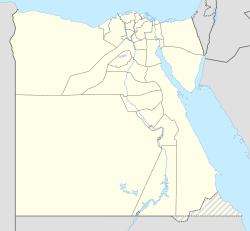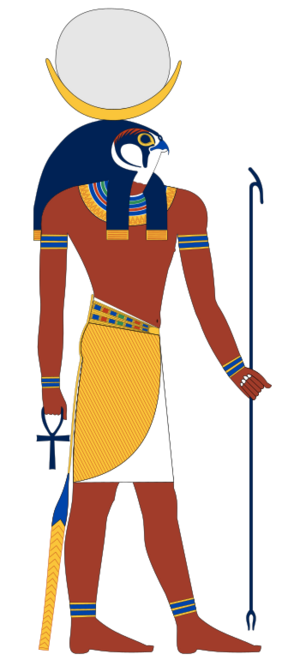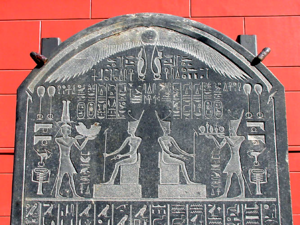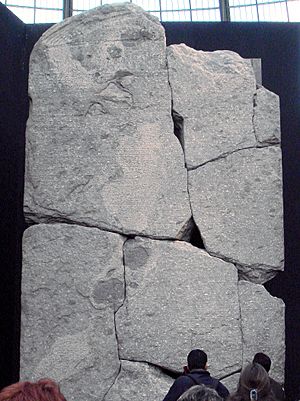Heracleion facts for kids
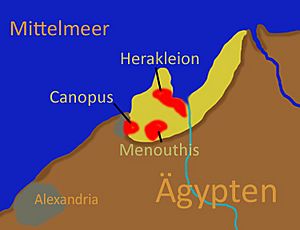
Map of Nile Delta showing ancient Canopus, Heracleion, and Menouthis
|
|
| Location | near Alexandria, Egypt |
|---|---|
| Coordinates | 31°18′46″N 30°07′44″E / 31.31278°N 30.12889°E |
Heracleion (also called Thonis or Thonis-Heracleion) was an amazing ancient Egyptian port city. It was located near the Canopic Mouth of the Nile River, close to where Alexandria is today.
This important city eventually sank into the sea. Its remains are now found in Abu Qir Bay, about 7 km (4.3 mi) off the coast. They lie under about 19 ft (5.8 m) of water. The city was known by both its Egyptian name, Thonis, and its Greek name, Heracleion.
The story of Thonis began as early as the 12th century BC. Ancient Greek historians wrote about it. The city became very important during the later years of the pharaohs' rule.
Contents
A City of Trade and Temples
Thonis was built on several islands in the Nile Delta. The city grew around a main temple. It had many canals, harbors, and places for ships to dock. Ferries, bridges, and pontoons connected its docks, temples, and tower-houses.
The city was a major trading port. During the Late Period of ancient Egypt, it was the country's main port for international trade. It also collected taxes on goods. Thonis had a sister city called Naucratis, which was another trading port further up the Nile. Goods were sent inland through Naucratis. They could also travel through a water channel to the nearby town of Canopus.
Thonis had a large temple dedicated to Khonsu, the son of Amun. The Greeks knew Khonsu as Herakles. Later, the worship of Amun became even more important. Between the sixth and fourth centuries BC, a huge temple for Amun-Gereb stood in the city center. Amun-Gereb was the most important Egyptian god at that time.
King Nectanebo I added many parts to this temple in the fourth century BC. Other temples in Heracleion were dedicated to Osiris and other gods. These temples were famous for healing people. Many pilgrims came from far away to visit them. Archaeologists have found proof that the "Mysteries of Osiris" were celebrated here every year. During this festival, a ceremonial boat carried the god from the Amun temple to his shrine in Canopus.
Why the City Sank
In the second century BC, the city of Alexandria became Egypt's main port. This meant Thonis-Heracleion started to lose its importance. Alexandria was only about fifteen miles southwest.
Also in the 2nd century BC, a big natural event hit the city. It might have been a tsunami, an earthquake, or both. This event caused a lot of damage. However, the city was not completely empty until it fully sank into the sea around 800 AD.
Over time, earthquakes, tsunamis, and rising sea levels weakened the city. Around the end of the second century BC, the ground under Heracleion's central island turned into liquid. This is called soil liquefaction. Earthquakes can cause this to happen. Ancient historians wrote about earthquakes and tidal waves during the time Thonis-Heracleion sank. The hard clay soil quickly turned into a liquid, and buildings collapsed into the water.
A few people stayed in the city during the Roman and early Arab times. But by the end of the eighth century AD, what was left of Thonis was completely under the sea. The city lay undisturbed for 1200 years. Sand and other debris covered its remains, keeping it safe and preserved.
Ancient Greek Stories
Many ancient Greek historians wrote about Thonis-Heracleion. These include Strabo, Diodorus, and Herodotus. They often mentioned the city in stories about famous Greek figures like Heracles and Paris. They described the city as being on the coast, next to the Nile.
Strabo wrote that Thonis was located on a strip of land between the Mediterranean Sea and a canal. Its name came from its king.
Diodorus told a story about Heracles and the Nile River. He said the Nile once flooded a large area. The river flowed so fast it was called the Aëtus, or "eagle." Heracles stopped the flooding and put the river back in its normal path. Diodorus claimed the myth of Heracles slaying the eagle that ate Prometheus's liver came from this event. He said Thonis stood where the Nile now flowed into the Mediterranean.
Herodotus wrote that Paris and Helen of Troy landed near the Canopic mouth of the Nile. They were running away from Menelaus. Some of Paris's servants ran to a nearby temple of Heracles. They told the priests and Thonis, the watchman of the Nile's entrance, about Paris taking Helen. Thonis then captured Paris and his ships. He took Paris and Helen to Memphis to be judged by Proteus of Egypt.
Another story says that Menelaus and Helen stayed in Thonis. They were guests of the noble Egyptian Thon and his wife Polydamna. A Greek poet named Nicander wrote that Menelaus's helmsman, Canopus, was bitten by a snake on the sands of Thonis.
Egyptian Records
{{Blockquote|Until very recently the site had been known only from a few literary and epigraphic sources, one of which interestingly mentions the site as an emporion, just like Naukratis.|British Museum, 2013.
Heracleion is also mentioned in two stone tablets called steles from the Decree of Nectanebo I. These steles say that one-tenth of the taxes on goods coming through Thonis (Heracleion) should go to the ancient temple of Neith in Sais. The discovery of the second stele helped prove that Thonis and Heracleion were the same city.
Finding the Lost City
Before 2000, most historians thought Thonis and Heracleion were two different cities. They believed both were on the Egyptian mainland. But in 2000, the French underwater archaeologist Franck Goddio and his team found the ruins submerged in the sea. They worked with the Ministry for Antiquities of Egypt.
Goddio's team searched for five years. They first studied old historical texts to guess where the city might be. Then, they used advanced technology to map the site. This included a nuclear magnetic resonance magnetometer, multi-beam bathymetry, and side-scan sonar. These tools helped them create detailed maps of the underwater area.
After mapping, the team slowly began digging. They used a grid reference system to record the exact spot of every artifact. They also used a water dredge to uncover items. The team included archaeologists, artists, and photographers to document everything. They worked on a tight schedule for about a month at a time.
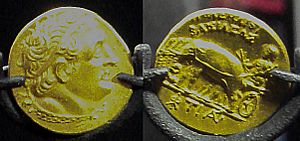
The team's rule is to leave artifacts in place unless they get permission to raise them. If an artifact needs to be brought up, they tag it and put it in a plastic bag. Then, they raise it to the surface in a basket. For very large items, like statues, they use a crane from their ship. Once on the ship, artifacts are cleaned and go through a desalination process. This protects them from the dry air after being underwater for so long.
Many discoveries show that the city was most active from the sixth to the fourth century BC. Finds of pottery and coins stop around the end of the second century BC. Goddio's team also found broken statues of the god Serapis and Queen Arsinoe II.
Today, underwater archaeologists use 3D technology more often. This helps them scan sites and create very accurate maps and images. This is especially helpful for cities like Heracleion that are underwater.
See also
 In Spanish: Heracleion para niños
In Spanish: Heracleion para niños
- List of ancient Egyptian towns and cities
- Menouthis


